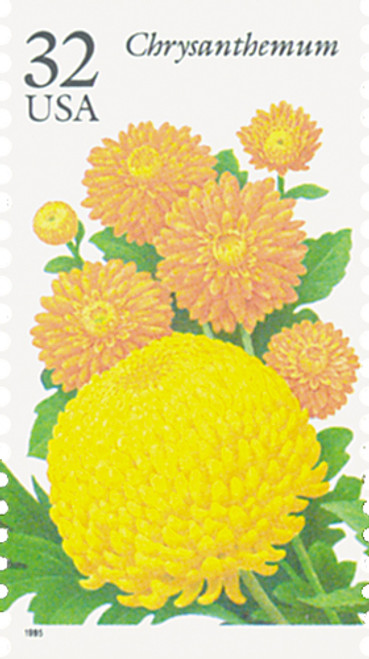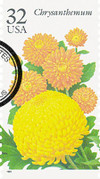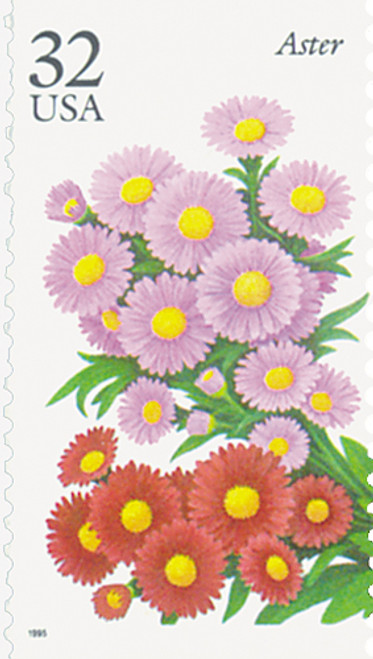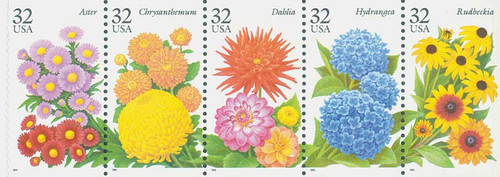
# 2994 - 1995 32c Fall Garden Flowers: Chrysanthemum
U.S. #2994
1995 Chrysanthemum
Fall Garden Flowers
- Third issue in the Garden Flowers Series
Stamp Category: Commemorative
Series: Garden Flowers
Value: 32¢ First-Class postage rate
First Day of Issue: September 19, 1995
First Day City(s): Encinitas, California
Quantity Issued (if known): 200,000,000
Printed by: Bureau of Printing and Engraving
Printing Method: Offset (flower images) Intaglio (type)
Format: Booklet of 20 stamps. Four booklet panes of 5 stamp strips.
Perforations: 10.9
Why the stamp was issued: The stamp was issued as part of the third installment of the Garden Flower Series. This stamp fulfilled the then-current first-class postage rate of 32¢.
First Day City: The ceremony was held at the Quail Botanical Gardens in Encinitas, California.
About the Garden Flowers Series: On May 15, 1993, the USPS issued the first installment in the Garden Flower Series, which would honor flowers that bloom in each of the four seasons.
This series was born out of the 1992 Wildflowers issue. That project had begun when the USPS asked an artist to produce color sketches of a group of garden flowers. Instead, the artist gave the USPS illustrations of wildflowers. The USPS liked them so much, it decided to create a 50-stamp pane, showing wildflowers that can be found in each state.
The USPS still liked the garden flowers idea. Part of the push behind these stamps had come from the sale of stamps in supermarkets and other retailers. People said they wanted “bright, pretty American stamps.” The USPS decided flower booklets would please the public. It ran TV commercials and full-page advertisements in stamp publications announcing “The flowers are in bloom at your post office. Buy them while they last!” and “Pick up a bunch.” The Garden Flowers booklet was the first to be produced on the new Goebel booklet machine, which was the first to print multicolor covers.
The stamps were issued on May 15, 1993, in Spokane, Washington at the 55th annual Spokane Lilac Festival and International Lilac Society Convention. Though not announced at the time, these stamps were to be the first in a new series of seasonal flower booklets.
The second booklet in the series was issued on April 28, 1994, at the Greater Cincinnati, Ohio, Flower and Garden Show. It featured summer garden flowers.
The third booklet in the series was issued on September 19, 1995, at the Quail Botanical Gardens in Encinitas, California. This booklet featured fall blooms.
The final booklet in the series was issued on January 19, 1996, in Kennett Square, Pennsylvania. The flowers selected for these stamps are the hardiest plants that grow anywhere in the country that experiences winter weather.
History the stamp represents:
Chrysanthemum
Chrysanthemums, native to Africa as well as Asia, are without question the flower of the East. They’ve been cultivated and cherished in China for over 2,000 years and in Japan almost as long. Their noble image appears on porcelain, in textiles, and on wood.
In China, Juxian was named the “City of Chrysanthemums” in A.D. 400 because it was the home of the flower’s greatest cultivator. Until quite recently, only the nobility could grow the showy flower. The sixteen-petalled Hironishi chrysanthemum was so loved in Japan, it became the emblem of the emperor in 797 and the national flower in 910. Today, Japan’s October chrysanthemum festival is the fall counterpart of its spring cherry blossom festival.
Chrysanthemums were introduced into Europe and America in the early 19th century. Using Latin and Greek, European botanists gave this member of the daisy family the name “golden flower.” The name remains even though today’s mums come in all sizes and colors except blue. Each blossom is made up of multiple independent flowers that can appear as a tiny, tightly packed pompon or an elegant 8-inch corsage. Florists now produce chrysanthemums throughout the year – a testimony to the flower’s universal appeal.
U.S. #2994
1995 Chrysanthemum
Fall Garden Flowers
- Third issue in the Garden Flowers Series
Stamp Category: Commemorative
Series: Garden Flowers
Value: 32¢ First-Class postage rate
First Day of Issue: September 19, 1995
First Day City(s): Encinitas, California
Quantity Issued (if known): 200,000,000
Printed by: Bureau of Printing and Engraving
Printing Method: Offset (flower images) Intaglio (type)
Format: Booklet of 20 stamps. Four booklet panes of 5 stamp strips.
Perforations: 10.9
Why the stamp was issued: The stamp was issued as part of the third installment of the Garden Flower Series. This stamp fulfilled the then-current first-class postage rate of 32¢.
First Day City: The ceremony was held at the Quail Botanical Gardens in Encinitas, California.
About the Garden Flowers Series: On May 15, 1993, the USPS issued the first installment in the Garden Flower Series, which would honor flowers that bloom in each of the four seasons.
This series was born out of the 1992 Wildflowers issue. That project had begun when the USPS asked an artist to produce color sketches of a group of garden flowers. Instead, the artist gave the USPS illustrations of wildflowers. The USPS liked them so much, it decided to create a 50-stamp pane, showing wildflowers that can be found in each state.
The USPS still liked the garden flowers idea. Part of the push behind these stamps had come from the sale of stamps in supermarkets and other retailers. People said they wanted “bright, pretty American stamps.” The USPS decided flower booklets would please the public. It ran TV commercials and full-page advertisements in stamp publications announcing “The flowers are in bloom at your post office. Buy them while they last!” and “Pick up a bunch.” The Garden Flowers booklet was the first to be produced on the new Goebel booklet machine, which was the first to print multicolor covers.
The stamps were issued on May 15, 1993, in Spokane, Washington at the 55th annual Spokane Lilac Festival and International Lilac Society Convention. Though not announced at the time, these stamps were to be the first in a new series of seasonal flower booklets.
The second booklet in the series was issued on April 28, 1994, at the Greater Cincinnati, Ohio, Flower and Garden Show. It featured summer garden flowers.
The third booklet in the series was issued on September 19, 1995, at the Quail Botanical Gardens in Encinitas, California. This booklet featured fall blooms.
The final booklet in the series was issued on January 19, 1996, in Kennett Square, Pennsylvania. The flowers selected for these stamps are the hardiest plants that grow anywhere in the country that experiences winter weather.
History the stamp represents:
Chrysanthemum
Chrysanthemums, native to Africa as well as Asia, are without question the flower of the East. They’ve been cultivated and cherished in China for over 2,000 years and in Japan almost as long. Their noble image appears on porcelain, in textiles, and on wood.
In China, Juxian was named the “City of Chrysanthemums” in A.D. 400 because it was the home of the flower’s greatest cultivator. Until quite recently, only the nobility could grow the showy flower. The sixteen-petalled Hironishi chrysanthemum was so loved in Japan, it became the emblem of the emperor in 797 and the national flower in 910. Today, Japan’s October chrysanthemum festival is the fall counterpart of its spring cherry blossom festival.
Chrysanthemums were introduced into Europe and America in the early 19th century. Using Latin and Greek, European botanists gave this member of the daisy family the name “golden flower.” The name remains even though today’s mums come in all sizes and colors except blue. Each blossom is made up of multiple independent flowers that can appear as a tiny, tightly packed pompon or an elegant 8-inch corsage. Florists now produce chrysanthemums throughout the year – a testimony to the flower’s universal appeal.














